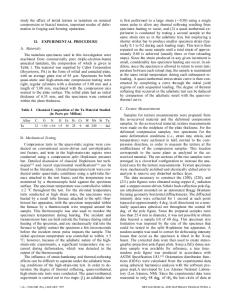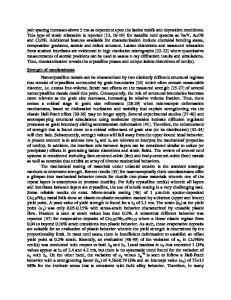The Mechanical Properties of the Novel Nanocrystalline Refractory Tantalum Alloys
- PDF / 735,220 Bytes
- 7 Pages / 612 x 792 pts (letter) Page_size
- 88 Downloads / 392 Views
ANOSCALE AND NANOSTRUCTURED MATERIALS AND COATINGS
The Mechanical Properties of the Novel Nanocrystalline Refractory Tantalum Alloys Mateusz Sopataa, Piotr Siwakb, Grzegorz Adameka, and Jaroslaw Jakubowicza, * a
Poznan University of Technology, Institute of Materials Engineering, Jana Pawla II 24, Poznan, 61-138 Poland bPoznan University of Technology, Institute of Mechanical Technology, Poznan, 60-965 Poland *e-mail: [email protected] Received January 8, 2019; revised February 9, 2019; accepted March 15, 2020
Abstract—The nanocrystalline tantalum alloys were investigated in terms of mechanical properties. The materials were obtained by powder metallurgy techniques—mechanical alloying (MA) and hot pressing (pulse plasma sintering mode). Pure powders of niobium, molybdenum, and tungsten were used for tantalum as an additive element in the concentration of 5, 10, 20, and 40 wt %. The analysis of XRD (Williamson–Hall equation) and TEM confirmed a significant reduction of the grain size (5.3–25.7 nm) for pure powders and (12.5–171.5 nm) for bulk hot-pressed elements. The nanoindentation test was used to study the mechanical properties. The load-displacement curves show high uniformity of the mechanical properties. The nanocrystalline alloys show very high hardness and stiffness. The highest value of hardness reached 1481 HV for Ta– 10Mo composition. Significantly higher values of hardness compared to pure Ta-nano were measured for Ta–W system. The Young’s modulus increased twice up to 343 GPa for Ta–20Mo in comparison to the unalloyed nanocrystalline Ta (163 GPa). In the novel nanocrystalline tantalum alloys, both solid solution and grain boundary strengthening affected on high mechanical properties. Keywords: nanocrystalline tantalum alloys, refractory metals, mechanical alloying, mechanical properties, hot pressing DOI: 10.1134/S2070205120040231
1. INTRODUCTION Refractory metals are the materials that retain their strength at high temperatures and resist wear. Five common elements that are known as refractory metals are tantalum, niobium, molybdenum, tungsten, and rhenium. They all have very similar properties including high melting point above 2000°C and hardness. All of them are chemically inert which makes them highly resistant to corrosive agents and concentrated acids [1–3]. Given the above properties, processing refractory metal is difficult. Conventional metallurgy is very often inadequate. Tantalum is one of such materials. It is characterized by the following properties: high melting point of 3017°C, the density of 16.65 g/cm3 and modulus of elasticity at 20°C—186 GPa. A very good corrosion resistance makes it a valuable material for chemical applications. It has a body-centered cubic crystal system. Tantalum may be enriched with alloying additives such as carbon, nitrogen, tungsten, molybdenum, niobium, and titanium. By adding small amounts of additives, the properties of the material can be changed. The additional 10 wt.% of tungsten may result in a double increase of the Vickers hardness
Data Loading...











